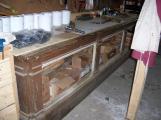1
While much of southern Newfoundland was quite barren, pockets of forests were significant enough to attract interest in logging and sawmilling. One of these areas was Bay d'Espoir, a riverine valley which had the largest timber stands comprising over 100 square miles. The sawmilling industry depended on choice softwoods, primarily balsam fir, black and white spruce having breast high diameters greater than 10 inches straight and free of live branches for at least 15 feet. The quantity of large trees of commercial value found in this area was not as great by the 1920's as previously because of the amount of cutting, particularly since the beginning of the sawmilling industry.3
As sawmills were established in the region, the demand for sawlogs meant an increase in logging activity. The process of logging started with the loggers leaving their homes and going to logging areas, making the trip on a daily or weekly basis. Once cut and trimmed with axes, logs were transported by the shortest available route to various waterways. Usually, logs would be driven down streams or rivers where they would be rafted in preparation for towing to the mills to be sawn. Once sawn, the mill owners would generally sell the processed lumber along the South Coast of the island, from St. Mary's to Port Aux Basques.4
In the early years of operations, the sawmills were steam operated. They burned slabs of wood as fuel for their boilers for the main source of power. Generally, sawmills did not operate during the winter months, because logs would freeze in the booms and accurate sawing of frozen logs was virtually impossible.Mills would saw anywhere from 150 to 200 logs per day, depending on the skill and experience of the sawyers. As demand for logs by the mills grew, so too did the need for additional workers resulting in increased migration of people to Bay d'Espoir, particularly to Head Bay d'Espoir and Milltown. These migrants came from Fortune as well as from the settlements scattered throughout the Hermitage Bay region.
While later settlers (post 1894) were largely dependant on the sawmilling industry for work, earlier settlers in the region had, over the years, sustained themselves through a multi based economy. These earlier settlers had established markets for their timber, produce and wildlife products along the South Coast of the province and in St. Pierre. These products would be traded for goods needed by the settlers which were not readily available here. As a result, these earlier settlers were not dependant on the sawmills for a living even though many did cut up to 50 logs for the mills during the summer months while obtaining timber for other products to be traded along the coast.
The shift to greater dependence on the sawmills by these earlier settlers did occur over time and by 1900, over half of them were cutting sawlogs either on a full time or part time basis. Those who cut on a part time basis for the mills might be cutting part time in either the summer or winter seasons while those cutting full time would be cutting during the winter season (January to March) and part time in the summer season (June-August).
The growth and development of Bay d'Espoir was, in large part, directly related to the emergence of the sawmilling industry which commenced on a large scale circa 1894. Prior to the establishment of Lake's sawmill in 1894, the population of the Head Bay d'Espoir and Milltown area grew less than 3% annually. After the sawmill was established, that increase grew to 12% annually.
6
Merchant John E. Lake's business began in Fortune in 1868 based on the fishery and later expanded into shipbuilding and furniture manufacture. In 1894, John E. Lake established a large sawmill at Milltown employing up to 18 men, excluding loggers. With the addition of two more sawmills by 1905, one at Conne River and the other in Little River, this business developed into one of the largest on the South Coast of Newfoundland.Although the management of the mill returned home to Fortune each winter, a few of the mill workers remained to form part of a logging crew with the settlers. These crews generally consisted of eight to twelve men and were paid a fixed monthly salary.
John E. Lake went bankrupt in 1917, and his two sons Bert and Freeman took over the operation naming it the Milltown Lumber Company. Freeman later left the business and his cousin John P. Lake joined with Bert. The Milltown Lumber Company operated until the late 1940's.
7
Aerial view of Head of Bay d'Espoir and Roberts Brother's Mill1950
Head of Bay d'Espoir, NL, Canada


